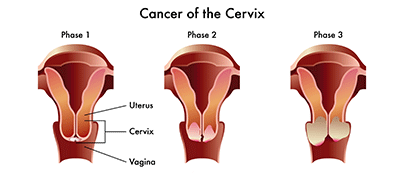Recipes
Cervical dysplasia refers to abnormal cells of the cervix that are not yet cancerous but have the potential to progress to cancer. These are precancerous lesions of the cervix that are diagnosed by a Pap smear.

In the United States, cervical cancer is the third most common cancer diagnosis and cause of death among gynecologic cancers. Over 12,000 new cases are diagnosed yearly with approximately 4000 cancer-related deaths each year. 1
Cervical dysplasia does not usually have accompanying symptoms; however, if it progresses to invasive cervical cancer, patients may experience:
The risk factors for cervical dysplasia and cancer are:
In my 25 years as a family physician I have seen several cases of cervical dysplasia and even early stage cervical cancer (carcinoma-in-situ) reverse itself and disappear in response to the Nutritarian diet and the recommendations discussed in the Action Plan. Though I do not have the scientific data to document how robust and predictable this would be, attempts to fund and plan these studies are being implemented.
ONLINE: All members of DrFuhrman.com can search the Ask the Doctor archives for discussions on this topic. Platinum and Diamond members can connect with Dr. Fuhrman by posting questions in the forum. Not a member? Join now.
IN PERSON: Book a stay at Dr. Fuhrman’s Eat to Live Retreat in Southern California. With options ranging from one, two and three months (and sometimes longer) you will be under Dr. Fuhrman’s direct medical supervision as you hit the “reset” button on your health. For more information: (949) 432-6295 or info@ETLRetreat.com.
EVENTS: Join Dr. Fuhrman for an online boot camp, detox or other event. During these immersive online events, you’ll attend zoom lectures, follow a special meal plan, and have access to a special, live Q&A session with Dr. Fuhrman. Learn more about events.
The following are sample questions from the Ask the Doctor Community Platinum and higher members can post their health questions directly to Dr. Fuhrman. (All members can browse questions and answers.)
Do you have any suggestions for a woman who has the type of HPV that causes cervical cancer who is being strongly encouraged to have surgery?
I have had many women reverse their cervical dysplasia using nutritional excellence. Mixed vegetable juice, blended salads, blended soups with broccoli sprouts and other cruciferous vegetables, and pomegranate juice should make up a considerable portion of your diet.
What exactly is this “human papilloma virus?” I hear about it all the time on commercials. Does a Nutritarian diet cure and/or prevent this? It’s hard to know if women should be really freaked out about this or is it just another way to sell another drug?
HPV is a sexually transmitted virus that is a major component in the cauldron of cervical cancer causation. An excellent, high nutrient diet boosts the immune defenses against the virus and can prevent the viral promoted pre-cancerous and cancerous changes.
What is your opinion on the HPV vaccine?
My opinion hinges on the risk/benefit ratio. In other words, if a person is sexually active with multiple partners then the risk of HPV infection increases. Cervical cancer is a sexually transmitted disease, but certainly one’s health and nutrition play a role in the resistance to these infections. If a person has always been in a mutually monogamous relationship, then the vaccine would be unnecessary. It is the grey areas that make these decisions difficult.
I just wanted to know exactly what cervical dysplasia is. My mom was just told she had it and needs some kind of procedure to remove it. She already had a colposcopy and now she needs to go under anesthesia and have this removed. Do you think this has anything to do with a poor diet and lack of exercise? Or stress? I know she isn’t promiscuous.
It is definitely the case that cervical dysplasia (cellular inflammation that occurs many years before cells become cancerous) is promoted by a poor diet and exposure to the HPV virus. It does not matter if she had multiple sexual partners because it only takes intercourse with one person who could have picked up the virus from someone else. Seventy-five percent of sexually active young people transmit the virus. I have seen many cases of cervical dysplasia reverse back to normal with excellent nutrition. I am sure if you continue to eat a diet rich in nutrients and cruciferous vegetables this will resolve. Have a glass of vegetable juice a few times a week too, from mostly carrot or tomato with added kale, bok choy, and parsley.